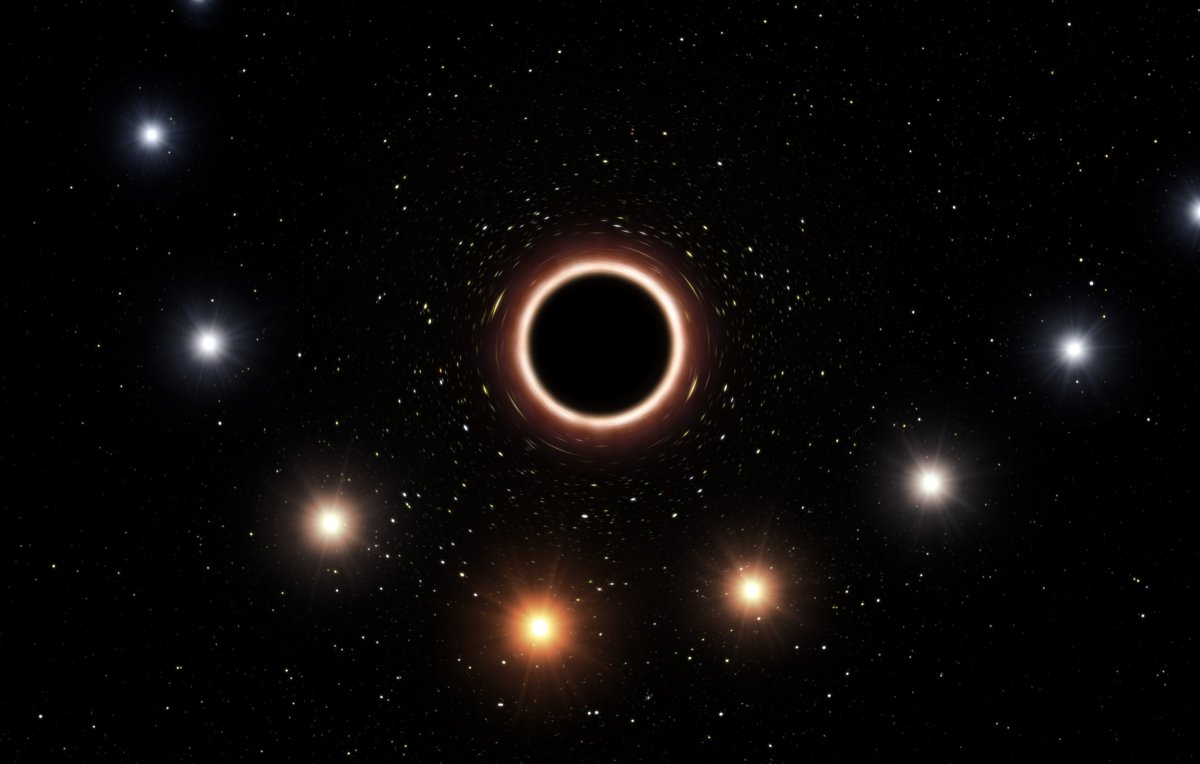An international team of scientists have completed the first successful test of Albert Einstein's famous theory of general relativity (GR) near a supermassive black hole, according to a study published in the journal Astronomy & Astrophysics.
Using the European Southern Observatory's (ESO) Very Large Telescope (VLT) in the Atacama Desert, Chile, researchers demonstrated that the theory accurately predicted the motion of a star passing through the extreme gravitational field surrounding Sagittarius A*—the supermassive black hole that is thought to reside 26,000 light-years from Earth at the center of the Milky Way.
This black hole has a mass equivalent to four million Suns and is encircled by a small group of stars orbiting it at high incredibly high speeds. The characteristics of this extreme environment make it an ideal place for scientists to test general relativity.
GR, which revolutionized science after its publication in 1915, describes the nature of gravity. It says that spacetime—a fusion of the three dimensions of space and the single dimension of time—is deformed by massive objects, such as black holes, and that this deformation affects the movement of objects in the Universe.
"There have been lots of tests of different predictions of GR—in tabletop experiments, in the Solar System, and in binary pulsar systems," Ingrid Stairs, an astrophysicist from the University of British Columbia, who was not involved in the study, previously told Newsweek.
But despite this, GR has never failed. In other words, general relativity accurately describes the nature of gravity in all the situations it has been tested in.
"That might sound remarkable—but if it ever failed, people would've given up on that theory," Stefan Gillessen, an author of the latest study from the Max-Planck Institute for Extraterrestrial Physics, told Newsweek.
Nevertheless, scientists are continually assessing the theory to make sure that these laws apply in all situations. These experiments could shed light on some of the biggest questions in physics, such as how to reconcile general relativity—which is good at describing massive objects—and quantum mechanics—the bizarre physics of the very small.
For the latest test of GR, scientists used precise infrared-detecting instruments on the VLT to track one of the fast-orbiting stars around Sagittarius A*, known as S2, as it passed "close" to the black hole in May 2018. At this point in time, S2 came within about 12 billion miles of the black hole while moving at speeds of more than 15 million miles per hour.
The team compared position and velocity measurements of the star made by the VLT's various instruments, as well as previous observations of S2, with the predictions made by general relativity, Isaac Newton's simpler theory of gravity, and alternative theories of gravity.
The results—which are the culmination of 26 years of ever-more-precise observations of our galaxy's center with ESO instruments—agreed precisely with the predictions found in general relativity, according to the researchers. However, they were inconsistent with Newton's theory—the first time that a deviation from his predictions have been observed in the motion of a star around a black hole.
The findings revealed a clear effect called gravitational redshift where light from S2 was stretched to longer wavelengths by the extreme gravitational field of the supermassive black hole—a process that agrees precisely with GR.
"This is the second time that we have observed the close passage of S2 around the black hole in our galactic center," Reinhard Genzel, Director of the Max Planck Institute for Extraterrestrial Physics and an author of the study, said in a statement.
"But this time, because of much improved instrumentation, we were able to observe the star with unprecedented resolution," he said. "We have been preparing intensely for this event over several years, as we wanted to make the most of this unique opportunity to observe general relativistic effects."
The findings are significant because they prove that Einstein's theory works even in extreme environments, according to Françoise Delplancke, head of the System Engineering Department at ESO.
"Here in the Solar System we can only test the laws of physics now and under certain circumstances," he said in the statement. "So, it's very important in astronomy to also check that those laws are still valid where the gravitational fields are very much stronger."

The new study is just the latest in a series of publications proving Einstein right.
In a paper published earlier this month, scientists demonstrated that Einstein's general theory of relativity (GR) works in other extreme gravitational environments. Meanwhile, a different paper published in June confirmed that GR can accurately describe the behavior of gravity in distant galaxies.
Finally, new findings from researchers at the Department of Energy's Oak Ridge National Laboratory have supported a theory first proposed by Albert Einstein in 1911 that explains how heat moves through solids.
The Very Large Telescope is ESO's flagship facility and the world's most advanced visible-light astronomical observatory, consisting of four Unit Telescopes with main mirrors measuring 8.2 meters in diameter.
The telescopes can work together by combining light beams they detect using a complex system of subterranean mirrors in order to reconstruct images with a resolution equivalent to distinguishing the two headlights of a car at the distance of the Moon.
Uncommon Knowledge
Newsweek is committed to challenging conventional wisdom and finding connections in the search for common ground.
Newsweek is committed to challenging conventional wisdom and finding connections in the search for common ground.
About the writer
Aristos is a Newsweek science reporter with the London, U.K., bureau. He reports on science and health topics, including; animal, ... Read more
To read how Newsweek uses AI as a newsroom tool, Click here.








